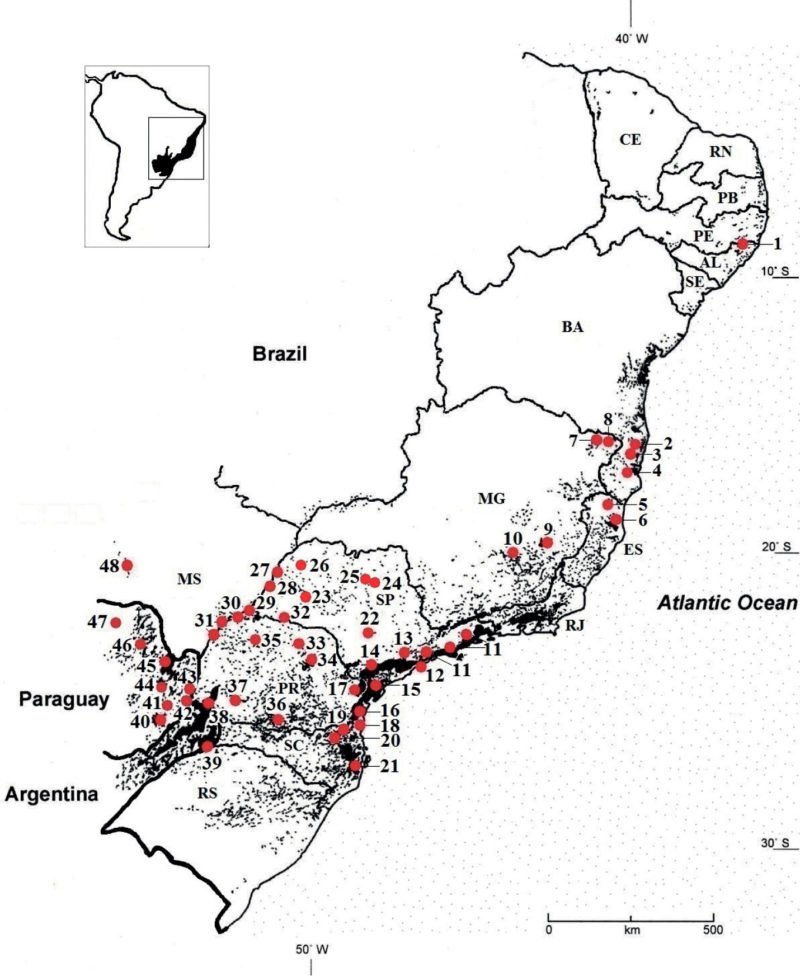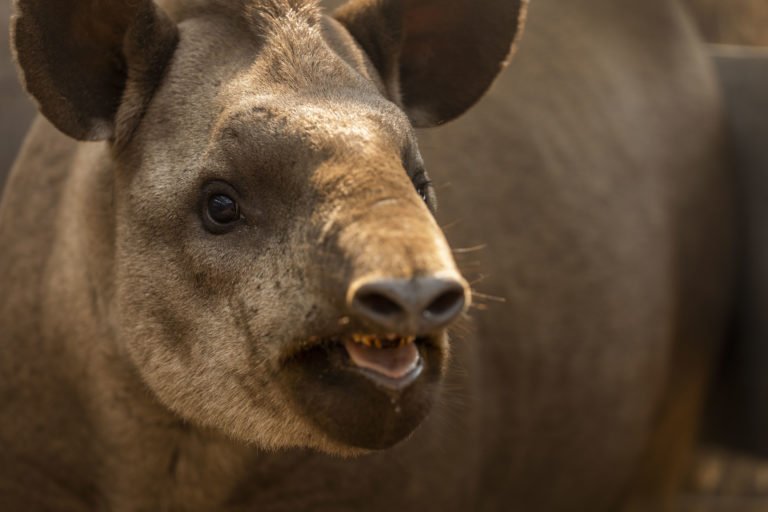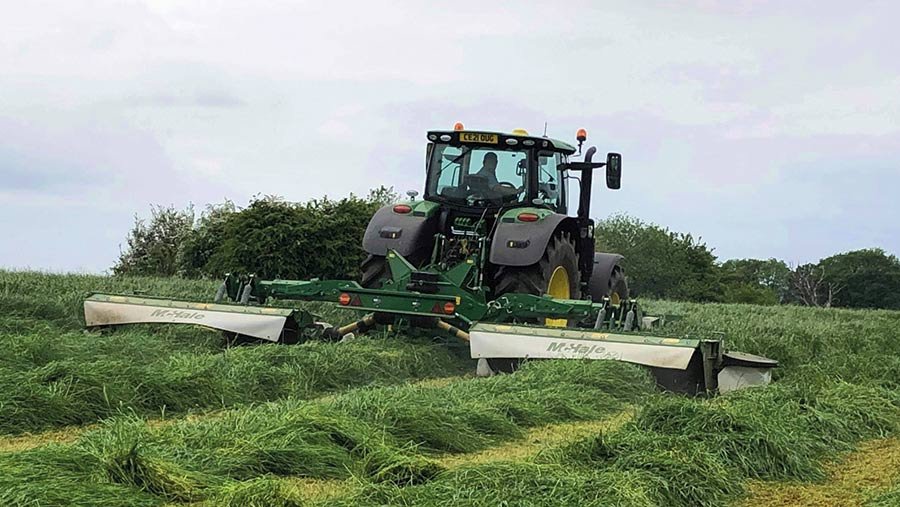- Lowland tapirs today occupy less than 2% of their historic range in the Atlantic Forest, and only a handful of their populations are deemed viable over the long term, a new study has found.
- A key factor in the unviability of most of the populations is the fragmentation of their habitat, which isolates small groups away from each other and often far from their sources of food.
- The study authors say the biggest threat to the species today is being struck by vehicles as they cross busy highways in search of food, while another threat comes from their slow reproductive rate, which translates into deaths outnumbering births.
- But the authors say they maintain some optimism, given that their study found tapir populations in the Atlantic Forest are stable or showing signs of growth — an improvement over the situation only a few decades ago.
In Brazil, calling someone a tapir is usually an insult. But there’s plenty of reason it should be seen as a compliment.
Few animals are as essential, underestimated and persecuted as Tapirus terrestris, South America’s largest native land mammal and one of the planet’s most efficient promoters of biodiversity.
Contrary to popular opinion in Brazil, the tapir is an intelligent animal with a high concentration of neurons, similar to the elephant. In the past, it was hunted in the Atlantic Forest to the point where it was declared a vulnerable species.
Found to be a key player in maintaining plant diversity by dispersing important seeds over large areas in a study by São Paulo State University (UNESP), the tapir has earned its fame as the “gardener of the forest.”
But to ensure its own sustainability, the Brazilian tapir of the Atlantic Forest needs urgent actions to fight the problems associated with the increasing fragmentation of its population. An expansive road networks cuts through their habitat, making it difficult for the tapirs to travel between forest fragments, and often resulting in the animals being hit and killed by vehicles.
These are the findings from a recent study carried out by Kevin Flesher, a researcher at the Center for Biodiversity Studies at the Michelin Ecological Reserve in Brazil’s Bahia state, and Patrícia Medici, co-founder of the Ecological Research Institute (IPÊ) and one of the world’s leading tapir specialists. The study assessed tapir distribution and conservation status in the Atlantic Forest, which spans parts of Brazil, Argentina and Paraguay.
Published in the journal Neotropical Biology and Conservation, the study shows that even though tapirs are restricted to 1.78% of their original habitat in the Atlantic Forest, it seems that most populations are stable or showing signs of growth.
“Tapirs persist in tiny areas with small, disconnected populations that are far from being in a secure state of conservation,” Medici says. “The truth is that the situation is better than in the past, when tapirs were extinguished in many parts of the Atlantic Forest. The population has remained stable over the last few decades, but if we don’t take careful action, the situation will get worse.”
Medici chairs the tapir specialist group at the IUCN, the global conservation authority. The group comprises 130 members in 27 countries, and focuses on the four known tapir species: the South American or lowland tapir (Tapirus terrestris), the mountain tapir (T. pinchaque), found in the Andes; the Central American tapir (T. bairdii); and the Malayan tapir (T. indicus), found in Southeast Asia. The latter three are considered endangered on the IUCN Red List, while the lowland tapir is listed as vulnerable.
Few viable populations remaining
Already wiped out along the lower slopes of the coastal range in southern Rio de Janeiro state and in parts of the Brazilian northeast by the late 19th century, the lowland tapir was confined to the Atlantic Forest, where it faced a critical period from the 1950s to the 1970s. Hunting during this time slashed the remaining population, and isolated small groups of tapirs into ever more fragmented patches of forests.
Current research shows there are at least 48 populations peppered across 26,654 square kilometers (10,291 square miles) of the Atlantic Forest — just a fraction of the biome’s original expanse of 1.5 million km2 (579,000 mi2). The estimated number of tapirs in the biome ranges from 2,665 to 15,992, with the largest group (numbering between 1,000 and 6,000 individuals) found in the forests that straddle Iguaçu National Park in Brazil’s Paraná state and the province of Misiones in Argentina.

But this population group is an outlier; most of the other groups are much smaller, some numbering only around six animals. This is the case in the Mata Escura Biological Reserve in the state of Minas Gerais, where the local population is nearing extinction.
In fact, of the 48 tapir populations studied, only three to 14 groups are considered viable in the long term, both from a demographic point of view — that is, if there are enough individuals to survive when faced with existing threats in the region — and a genetic one. Genetically, the risk is that individuals from the same family interbreed, degrading genetic diversity and raising the risk of disorders caused by recessive genes.
This population viability analysis, used to estimate the number of animals in a given location, and whether this number is enough to survive over a 100-year period, paints a worrying picture for the tapir.
“The population viability analysis is what tells us if an animal will merely persist in a place or if it belongs to a population that should still exist 100 years [from now],” Medici says. “The magic number is to have between 200 and 250 tapirs [per population group]. This is the necessary amount for stabilizing a healthy population considering normal impacts and for maintaining their genetic viability.”

Flesher says small populations are at high risk when they have to cross roads to find enough food to eat. The tapir’s reproductive cycle also poses a risk factor. Females typically get pregnant only once in three years. The pregnancy lasts 14 months and produces just one calf. This leaves populations susceptible to rapid decline, especially if the number of animals in a given area is small. The loss of a single individual can mean local extinction.
Medici says there’s an urgent need to adopt measures to guarantee the safety of animals moving from one patch of forest to another. Many end up as roadkill when trying to cross busy highways like the BR-101, which cuts through the Brazilian section of the Atlantic Forest from north to south.
“I have no qualms or doubts in saying that the greatest threat to tapirs in our country today is from cars on the highway,” Medici says. “The road network will only expand and the problem will increase with it. Our strategy is to prepare mitigation plans such as underpasses, fences, signs and radars at the critical places where many tapirs are known to die from crossing the highway. We have very efficient tools. What we don’t have is the political drive to pressure the concessionaires running these highways to do what needs to be done.”
Despite the prevailing risks, Medici and Flesher say they still harbor some optimism about the situation of the tapir in the Atlantic Forest, especially the larger populations and in areas where agriculture and livestock farming have declined.
“From what we have seen in the field, there is less hunting going on, especially in the southern and southeastern mountains,” Flesher says. “Land colonized there many years ago is being abandoned, so forests are able to grow back and the tapirs occupy these areas.”
He adds that in São Paulo state’s Serra do Mar State Park, home to one of the largest tapir populations in Brazil, “the animals are starting to descend the mountains almost far enough to enter the city of Caraguatatuba.”
Citation:
Flesher, K. M., & Medici, E. P. (2022). The distribution and conservation status of Tapirus terrestris in the South American Atlantic Forest. Neotropical Biology and Conservation, 17(1), 1-19. doi:10.3897/neotropical.17.e71867
Banner image by João Marcos Rosa/IPÊ.
This story was reported by Mongabay’s Brazil team and first published here on our Brazil site on Feb. 22, 2022.











